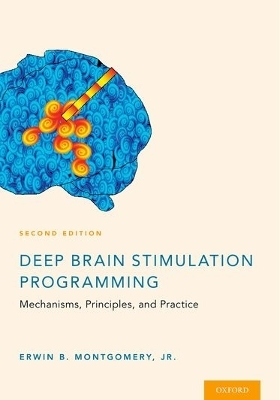
Deep Brain Stimulation Programming
Oxford University Press Inc (Verlag)
978-0-19-025960-0 (ISBN)
The second edition of Deep Brain Stimulation Programming is fully revised and up-to-date with the latest technologies and focuses on post-operative programing, which no other text does. This book provides programmers with a foundation of the brain as an electrical device, focusing on the mechanisms by which neurons respond to electrical stimulation, how to control the stimulation and the regional anatomy, and the many variations that influence a patient's response to DBS. Dr. Montgomery explores new techniques of programming; including those based on stimulation frequency, closed-loop DBS, and the roles of oscillators in DBS; and new technological advances that make pre-existing theories of pathophysiology obsolete.
Key Features of the Second Edition Include
· Highlights post-operative deep brain stimulation;
· Includes the most recent discoveries in deep brain stimulation programming;
· Highly illustrated with figures for absorption of key programming and techniques;
· Provides an appendix of additional resources available through the Greenville Neuromodulation Center.
Dr. Montgomery is a Movement Disorders Neurologist with a special interest in Parkinson's disease. He has conducted research in motor neurophysiology, particularly the role of the basal ganglia-thalamic-cortical system and the pathophysiology of Parkinson's disease for over 40 years. For the last 20 years, he has focused on deep brain stimulation in its clinical use and its underlying physiological mechanisms.
Table of Contents
Preface to the Second Edition
Preface to the First Edition
Abbreviations
Chapter 1. Introduction
The Fundamentals Still Pertain
Principles of Effective and Efficient Programming
The Basis of DBS Effects
Chapter 2. Principles of DBS Electronics
Electricity
Electronics
Note Regarding Impedances
Chapter 3. Principles of Electrophysiology
Therapeutic Mechanisms versus Delivery of Therapy
The Neuron
Neuronal Electronics
Voltage Gated Ionic Conductance Channels and Action Potentials
Downstream Secondary Issues
Chapter 4. Controlling the Flow of Electrical Charges
Orientation of the Lines of Electrical Force
Orthodromic and Antidromic Conduction of Action Potentials
Axon Diameter
Electrode Configurations
Current Intensity in Monopolar and Bipolar Electrode Configurations
Segmented DBS Leads
Chapter 5. DBS Safety
The Range of Safety Concerns
Injury Secondary to Electricity
Medical Complications
Adverse Effects Related to Activation of Neural Networks
The Potential Psychosocial Consequences of DBS
Chapter 6. Nervous System Responses to DBS
Knowledge of Nervous System Responses versus Knowledge of Therapeutic Mechanisms
Effects Mediated by Voltage-Gated Ionic Conductance Channels in the Neuronal Membrane
Post-Hyperpolarization Rebound Excitation, Depolarization Blockade, and Neurotransmitter Exhaustion
Dissociation of Effects on Action Potential Initiating Segment, Dendrites, and Cell Bodies
Network Effects of DBS
Critically Important Caveats Concerning Interpretation of Nervous System Responses to DBS
Reentry Propagations and Resonance
Synchronization Among Neurons
Interactions Between DBS Pulse in Intrinsic Neuronal Mechanisms
Effects on Behaviorally Related Intrinsic Neuronal Dynamic
Temporal Evolution of Nervous System Responses
Chapter 7. DBS Effects on Motor Control
Orchestration of Motor Unit Activities
Orchestration of Motor Unit Recruitment and De-Recruitment over Different Time Scales
Lessons to be Learned
Chapter 8. Pathophysiological Mechanisms
The Globus Pallidus Interna Rate Theory
Excessively High Beta Oscillations
Excessive Synchronization of Neuronal Activities
Excessive Bursting
The Systems Oscillators Theory
Chapter 9. Approaches to Programming
Battery Life
DBS Contact Nomenclature
Prior to DBS Programming
When to Program DBS
Conceptual Approaches
The Growing Importance of Monopolar Surveys
Detection of a Response is Critical
Programming for Optimal Benefit in the Absence of Adverse Effects
Programming to Prevent Adverse Effects
Exiting the DBS Programming Session
Chapter 10. Clinical Assessments
Clinical Assessments by Disease
Clinical Assessment of Corticospinal and Corticobulbar Stimulation
Clinical Assessment of Speech, Language and Swallowing
Hints to Clinical Evaluations
Chapter 11. Approach to Subthalamic Nucleus
Regional Anatomy of the Subthalamic Nucleus
Adverse Effects Created by the Position of the DBS Lead Relative to the STN
Approach to STN DBS for Parkinson's Disease
Chapter 12. Approach to Globus Pallidus Internal
Regional Anatomy of the Globus Pallidus Internal (GPi) Segment
Adverse Effects Resulting from the Position of the DBS Lead Relative to the GPi
Approaches to GPi DBS for Parkinson's Disease
Treating Dystonia with DBS of the Globus Pallidus Interna
Treating Hyperkinetic Disorders
Chapter 13. Approach to Thalamic DBS
Regional Anatomy of the Ventral Intermediate Thalamus
Adverse Effects Resulting from the Position of the DBS Lead Relative to the Ventral
Effects of DBS on Speech and Swallowing
An Approach to Thalamic DBS for Tremor
Chapter 14. Algorithm for Selecting Electrode Configurations and
Stimulation Parameters
Chapter 15. Helpful Programming Hints
Use of Constant-Voltage DBS (to be discouraged)
Conduct a Monopolar Survey
Always Increase the Voltage to Clarify Any Side Effects
Check Therapeutic Impedances on Commercial IPGs
Confirm that the Parameters under Patient Control are within Safe Limits
Systematically Document all Clinical Responses to all DBS Stimulation Parameters and Electrode Configurations
Always Reset Counters and Trouble-Shoot Inconsistent Responses
Advise Patents, Family Members and Caregivers to Take Their DBS Controlling Devices with Them to Emergency Rooms or Doctor's Visits
Be Patient and Persistent!
When in Doubt, Turn the Pulse Generator Off and Wait
Trouble Shooting
Chapter 16. Oscillator Basics
Chapter 17. Discrete Neural Oscillators
Importance of Neural Oscillators in Nervous System Function
Continuous harmonic oscillators
Discrete Oscillators
Single Reentrant Discrete Oscillator
Interactions Among Discrete Oscillators
Discrete Neural Oscillators
Oscillators with multiple realistic neurons
The Systems (Discrete) Oscillators Theory
Appendix of Supplemental Material
Glossary
References
| Erscheinungsdatum | 09.12.2016 |
|---|---|
| Verlagsort | New York |
| Sprache | englisch |
| Maße | 178 x 257 mm |
| Gewicht | 680 g |
| Themenwelt | Medizinische Fachgebiete ► Chirurgie ► Neurochirurgie |
| Medizin / Pharmazie ► Medizinische Fachgebiete ► Neurologie | |
| Medizin / Pharmazie ► Pflege ► Fachpflege | |
| ISBN-10 | 0-19-025960-4 / 0190259604 |
| ISBN-13 | 978-0-19-025960-0 / 9780190259600 |
| Zustand | Neuware |
| Informationen gemäß Produktsicherheitsverordnung (GPSR) | |
| Haben Sie eine Frage zum Produkt? |
aus dem Bereich


